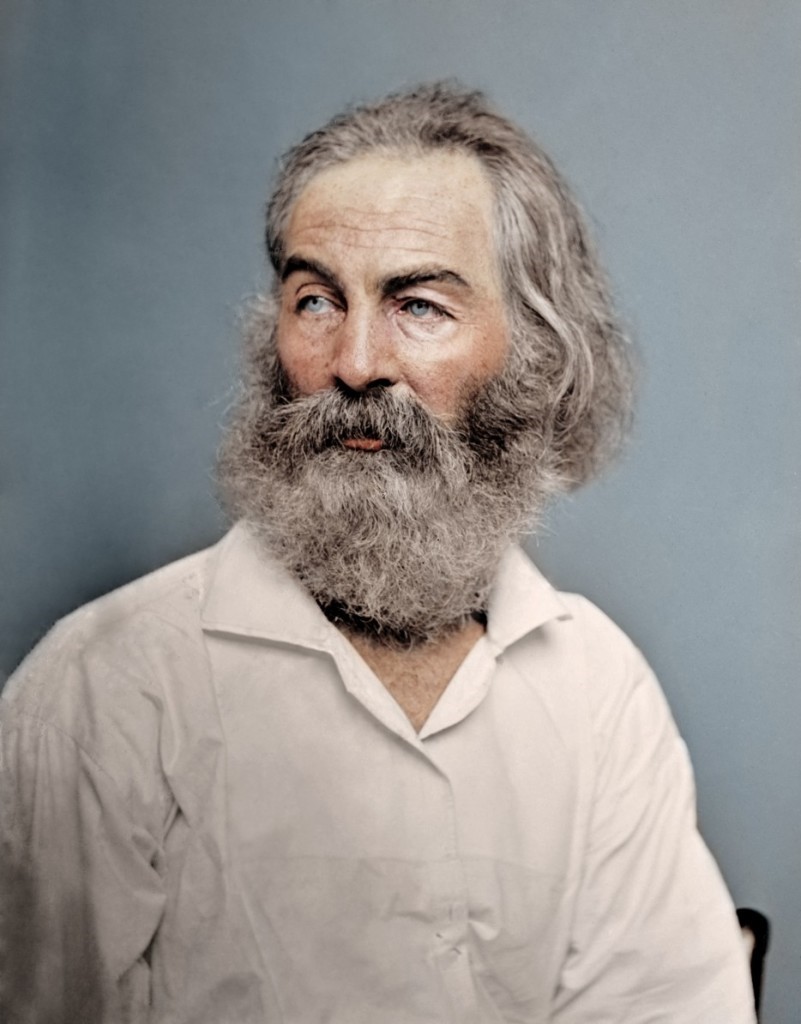by Mike Bradley
(2015) Poets in the 1800s were the rock stars of today. One of the biggest was Walt Whitman, whose most famous and controversial poetry collection was Leaves of Grass. He started writing Leaves of Grass in the early 1850s and was still working on and revising the collection till his death in 1892. He was considered the father of free verse, and was controversial for the sexual nature of his poetry and speculation about his personal life.
Whitman came to Canada in June of 1880 to visit his friend, Dr. Richard Maurice Bucke, a Canadian psychiatrist who was in charge of the Provincial Asylum for the Insane in London, Ontario. The Asylum had over 900 patients. Dr. Bucke was viewed as progressive and a reformer for the mentally ill. Walt Whitman visited Sarnia, the former home for 10 years of Dr. Bucke, where he had practiced general medicine specializing in psychiatry. (Whitman’s journal of his brief time here rarely shows up in the community’s history books. One wonders if it is because of the sexual nature of his poetry and controversy about his personal life).
Dr. Bucke was a brilliant man who, after living a colourful life, came to Sarnia in 1865 to take over his late brother’s medical practice. That same year he married Jessie Gurd and they would have eight children. He felt very isolated intellectually in Sarnia and wrote to a friend, “I live here in a state of Egyptian darkness as regards the light from the literary world.” Despite those feelings, or perhaps because he fell in love with the writings of Whitman (and some say Whitman, much to his wife’s dismay) Whitman met him in the U.S. in 1877, which began a life-long friendship with Bucke; eventually becoming his biographer. At the time of Whitman’s visit, Sarnia was a small town of 7,000 people. Rail and shipping drove the economy. A water pumping station had been built on George Street in 1875 which changed everyday life for citizens; bringing indoor plumbing to the community and piped water for the volunteer fire department. St. George’s Church and Our Lady of Mercy Church were about to be built. And the two projects that would take Sarnia on the path from being a backwoods town to becoming a City. In 1914, the St. Clair River Tunnel and Sarnia General Hospital, would be constructed within the decade. Mayor George Leys was Sarnia’s 13th Chief Magistrate in 1880 and a moral crusader. The Council of the day passed a bylaw to make it a crime to “profanely swear or utter any obscene or blasphemous or grossly insulting language.” Council also banned swimming unless people were wearing “suitable bathing dress.”
Here are some excerpts from Whitman’s diary, which give a fascinating insight of life in Sarnia in 1880. John A. MacDonald was Prime Minister of Canada. Five members of the Donnelly family had been murdered close by that February in Lucan. Port Huron native Thomas Edison had just tested his first electric railway. “Oh Canada” was sung for the first time in June.
“June 19th. On the train from London to Sarnia 60 miles. A fine country, many good farms, plenty of open land, the finest strips of woods clean of underbrush some beautiful clusters of great tree; plenty of fields with the stumps standing; some bustling towns.
(Same date: Sarnia) Sunset on the St. Clair. I am writing this on Front Street; close by the river; the St. Clair, on a bank. The setting sun, a great blood-red ball, is just descending on the Michigan shore, throwing a bright crimson track across the water to where I stand. The river is full of row-boats and shells, with their crews of young fellows, or single ones, out practising, a handsome inspiring sight. Up north I see at Point Edward on Canada side, the tall elevator in shadow, with tall square turret, like some old castle. As I write a long shell, with its crew of four striped to their rowing shirts, sweeps swiftly past their oars rattling in their row locks.
Opposite a little south, on the Michigan shore stretches Port Huron. It is a still, moist, voluptuous evening, the twilight deepening apace. In the vapours fly bats and big myriads of big insects. A solitary robin whistling his call, followed by mellow clucks, in some trees near. The panting of the locomotive and measured roll of cars comes from over shore, and occasionally an abrupt snort or screech, diffused in space. With all these utilitarian episodes, it is a lovely, soft voluptuous scene, a wondrous half-hour for sunset, and then the long rose-tinged half-light with a touch of gray we sometimes have stretched out in June at day-close. How musical the cries and voices floating in from the river! Mostly while I have been here I have noticed those handsome shells and oar-boats, some of them rowing superbly.
At nearly nine it is still quite light, the atmosphere tempered with blue film, but the boats, the river, and the Michigan shores quite palpable. The rose color still falls upon everything. A big river steamer is crawling athwart the stream, hoarsely hissing. The moon in its third quarter is just up behind me. From over in Port Huron come the just-heard sounds of a brass band, practising. Many objects half burnt hulls, partially sunk wrecks, slanting or upright poles throw their black shadows in strong relief on the clear glistering waters.”


